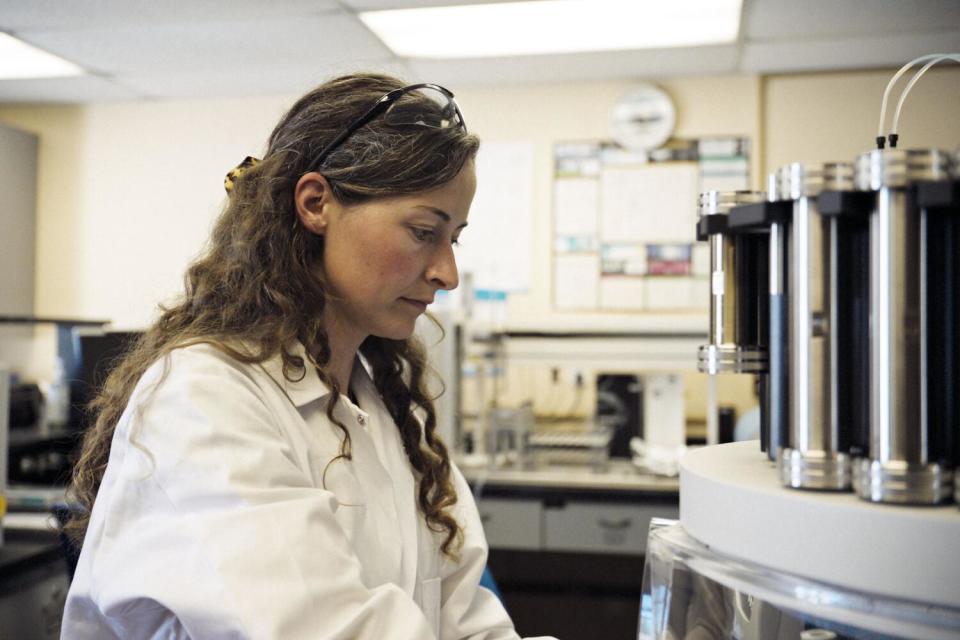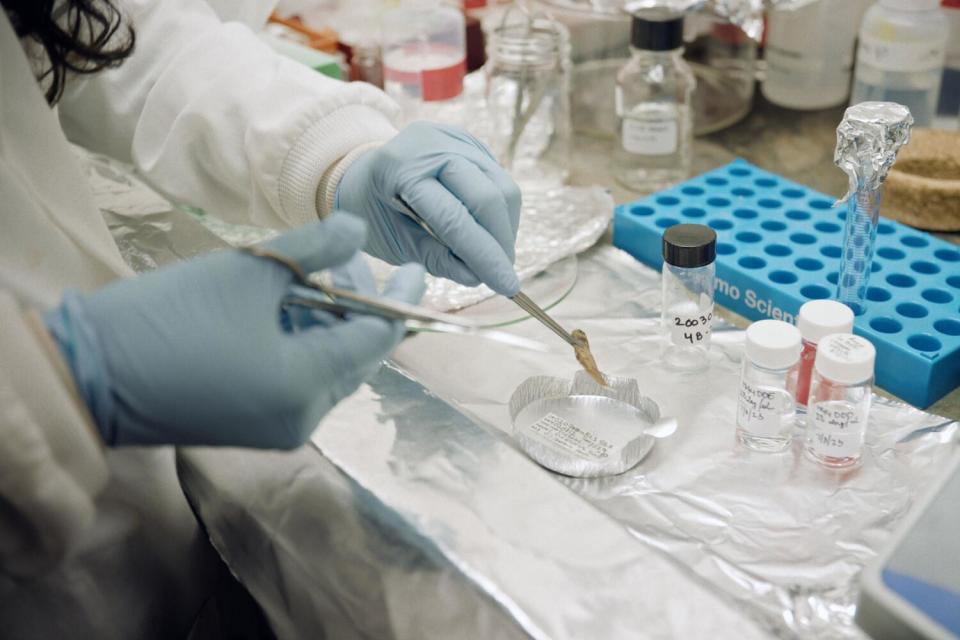One question has been key for several years to understanding how much we should worry about the hundreds of tons of DDT dumped off the coast of Los Angeles:
How exactly did this decades-old pesticide—a toxic chemical that spreads across the seafloor 3,000 feet underwater—reenter the food web?
Now, in a long-awaited study, researchers have identified small zooplankton and mid- to deep-water fish as potential connections between the contaminated sediment and the larger ecosystem.
For the first time, chemical analyzes confirmed that these deep-sea organisms are contaminated with numerous DDT-related compounds that match similar chemical patterns found on the seabed and in animals higher up the food chain.
“This DDT pollution happened decades ago, there is no new source, it is banned…but this old source is still contaminating the deep-sea biota, which is really alarming,” said Eunha Hoh, whose laboratory at San Diego State School of Public Health led the chemical analysis of the study. “We’re not talking about zooplankton collected in 1960 – we’re talking about zooplankton collected nowin the deep ocean, which is still contaminated with DDT.”
Hoh’s team had already found significant amounts of DDT-related chemicals in modern-day dolphins and coastal condors (and a recent study by another team even linked an aggressive cancer in sea lions to DDT). But even though DDT has clearly piled up at the top of the food chain, How the DDT reaching these animals was somewhat of a mystery. Key questions remain about whether it comes from more shallow sources (such as the Palos Verdes Shelf Superfund site, where DDT was discharged down the drain for years), or from the deep-sea sediment itself.
“The real [hits home] this concept that nothing remains untouched,” says Lihini Aluwihare, a chemical oceanographer whose laboratory at UC San Diego’s Scripps Institution of Oceanography has helped bring together the many multidisciplinary aspects of the research. “Identifying the current distribution of DDT- contamination in deep-sea food webs provides the basis for considering whether these contaminants also spread through deep-sea food webs to species that could be consumed by humans.”

The study, published Monday in Environmental Science & Technology Letters, is one of several research efforts sparked by a 2020 Los Angeles Times report that detailed the little-known history of ocean dumping off the coast of Southern California – and how the country’s largest manufacturer of DDT had been dumping its waste at sea for years.
A team of scientists, in an effort to map and scan the seabed for DDT-related waste, discovered a large number of discarded military explosives from the World War II era. Another team unearthed data showing that barrels of radioactive waste had also been dumped into the sea.
And in an urgent search for old and forgotten records, the U.S. Environmental Protection Agency discovered that between the 1930s and the early 1970s, thirteen other areas off the coast of Southern California had also been approved for all kinds of dumping – including disposal from various refineries. by-products and 3 million tons of petroleum waste.
Read more: The history of DDT dumping in the ocean off the coast of LA is even worse than expected, EPA finds
As for the DDT, which is short for dichlorodiphenyltrichloroethane, scientists have so far confirmed that much of what is still on the seabed remains in its most potent form and is buried barely 6 centimeters deep – raising concerns about how easily it could remobilize and spread. by re-entering the food web.
In a world dominated by concerns about microplastics and “forever chemicals,” DDT remains an unsolved problem — long after the pesticide was banned in 1972 following Rachel Carson’s book “Silent Spring.”
Read more: Here’s what we know about the legacy of DDT dumping off the coast of LA
With this latest study, researchers sought to show how the chemical is still likely to emerge from the deep-sea floor by coming into contact with zooplankton, which are eaten by deep-sea fish, which then swim around and are eaten by midwater fish. marine mammals are moving up the food chain.
Hoh joined forces with Aluwihare’s laboratory in Scripps, where a microbiology team also performed sediment analysis and helped a deep-sea biologist determine which organisms to sample – and where in Southern California to collect them.
In addition to zooplankton, which provide a window into the base of the food chain, a certain type of fish, myctofids, turned out to be crucial.


Myctophids, also known as lanternfish, are small, unassuming fish that travel remarkable distances, from the deep ocean to the surface. (One of the most common and widespread fish in the world, myctofids make up roughly 65% of all deep-sea biomass on Earth.) The researchers methodically ground up each fish sample and extracted the lipid (DDT is usually stored in fat), and assessed the contamination with a unprecedented level of scrutiny.
The findings were sobering: wherever they looked, they found DDT. Even the “control samples” they tried to collect – as a way to compare what a normal fish sample might look like further away from the known dumping area – were full of DDT.
“This is one of the missing pieces we’ve been waiting for,” says David Valentine, who has been leading the broader research community in this area since his team at UC Santa Barbara first shed light on the astonishing amounts of DDT still present are. spread over the seabed. “We know there’s a lot of stuff down there… but seeing these compounds in deep-living organisms really points to a connection.”
Valentine, who was not involved in the research, noticed some interesting new clues.
A key to tracking DDT’s legacy in the marine ecosystem is identifying and then comparing the patterns of each chemical found in different animals – a technique called “non-targeted analysis.” That could help figure out where all the DDT comes from, and how it moves and accumulates at different levels of the food chain.
Monitoring programs typically use a targeted approach: they look for only four to eight specific DDT compounds. But by using untargeted methods, scientists in this new study were able to identify a slew of DDT-related chemicals, including a particularly suspicious compound, TCPM, that poses unknown threats to the ecosystem. These currently unmonitored chemicals were also present in the blubber of dolphin carcasses that washed ashore, as well as in the sediment collected near the known dumping area.
“This gives us a much more realistic picture of what the potential impacts on the environment and human health could be,” said Mark Gold, an environmental scientist at the Natural Resources Defense Council. He said the study exposes how the traditional approach of testing and monitoring just a few DDT compounds “grossly underestimates the concentrations of DDT in sediment and in organisms.”
Gold, who was not involved in the research but has been pushing for DDT cleanup along the coast for more than three decades, said much more work needs to be done on all fronts to truly take into account the chemical’s legacy in Southern California. In addition to DDT spreading across the deep sea and the Palos Verdes Plateau, the mouth of the Dominguez Channel has also been identified as a hotspot for decades.
The road ahead is long. Twenty-four members of Congress, led by U.S. Senator Alex Padilla (D-Calif.) and Representative Salud Carbajal (D-Santa Barbara), recently urged the Biden administration to dedicate long-term funding to both studying and resolving the issue. Officials at the EPA, meanwhile, have been considering their next steps in collaboration with a number of state and federal agencies.
Academic research groups, including those in San Diego and those led by Valentine at UC Santa Barbara, also continue to search for answers. The most important of these are defining the boundary of the landfill, mapping the spread of the pollution and tracking its migration across the food web.
For environmental chemists Margaret Stack, the first author of the latest study, and fellow author Raymmah Garcia, a PhD student at Scripps, seeing once-popular pesticides like DDT so ubiquitous in the ecosystem makes them wonder what all the other chemicals are. that are still used today without question – chemicals that may continue to haunt us decades from now.
“I often find myself frustrated when I look at this data and see that we’re still using chemicals without testing them, without understanding their impact,” said Stack, a research specialist at San Diego State School of Public Health Health. “It feels like we’re not doing anything else.”
“How many times,” she said, “are we going to experience the same story again?”
This story originally appeared in the Los Angeles Times.